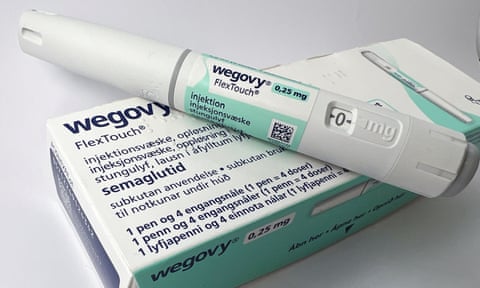Boiler-Plate Response to Heightened Drug Toxicity
"[Data from the study are not sufficient to establish a cause-and-effect association between semaglutide and NAION]; key methodological limitations of the study [need to be considered when interpreting the findings].""Patient safety is a top priority for Novo Nordisk, and we take all reports about adverse events from the use of our medicines very seriously.""Semaglutide has been studied in large real world evidence studies and robust clinical development programs with a cumulative exposure including from post-marketing use of over 22 million patient years.""The totality of data provides reassurance of the safety profile of semaglutide." Novo Nordisk
Semaglutide is most commonly known under the brand names Wegovy and Ozempic. Photograph: Reuters
A new American study has found that drugs containing the active compound semaglutide have a potential side-effect among certain users, presenting a dilemma in outcome.Last summer researchers at Mass Eye and Ear in Boston, Mass felt motivated to begin an investigation on whether the sought-after weight-loss drugs might be associated with increased risk of NAION. Their interest was piqued after three patients were diagnosed with a relatively rare eye condition.
The study conclusion was that Ozempic and other weight-loss drugs -- so hugely popular -- contain the active compound semaglutide, associated with increased risk of NAION, (nonarteritic anterior ischemic optic neuropathy). An eye-loss condition affecting two to ten in every 100,000 people annually. Sudden and permanent loss of vision in one eye as a result of insufficient blood flow and oxygen to optic nerves. The condition is also referred to as an "eye stroke", a significant cause of adult blindness.
Three patients at the Harvard Medical School who took semaglutide were diagnosed within the same week with AION. Published in JAMA Ophthalmology, the study found people who were prescribed semaglutide became seven times likelier to end with a diagnosis of NAION than were people prescribed different drugs for an overweight condition. Semaglutide prescribed for Type 2 diabetes saw people becoming four times more likely to be threatened with the rare eye diagnosis.
 |
| Getty Images |
"Our main finding is that prescribed semaglutide is associated with an increased risk of NAION", the researchers concluded. "We should be confident that if corroborated, the absolute risk of developing NAION in direct relation to taking semaglutide must indeed be rare", wrote University of Birmingham professor Dr. Susan Molan, who investigates rare diseases of the eye and brain. The findings "should be viewed as significant but tentative", cautioned Dr. Joseph Rizzo, director of the neuro-ophthalmology service at Mass Eye and Ear.
Ozempic and Wegovy are in a class of drugs called GLP-1 agonists, spurring the release of insulin, and lowering blood sugar, but act as well on the brain to curb appetite. Given through a once-weekly injection by a prefilled pen. A survey by Dalhousie University's Agri-Food Analytics lab, partnering with market research firm Caddle, found some ten percent of the Canadian adult population uses a GLP-1 type drug for diabetes control, weight loss, or both.
Reports of potential unforeseen side-effects inclusive of gastrointestinal problems and unplanned pregnancies have arisen with the growing popularity of the drug. The research team studied records of patients referred to their clinic from 2017 through to 2023, checking for NAOIN diagnoses. Records of close to 17,000 patients treated over six years were analyzed. Among them 629 NAION cases were diagnosed in that six-year period.
Divided into two groups those diagnosed with Type 2 diabetes and people living with obesity were separated to compare people who received prescriptions for semaglutide along with those taking other diabetes or weight-loss drugs. Among those with diabetes, 8.9 percent of the semaglutide-treated group developed NAION within three years of follow up, compared to 1.8 percent for the non-semaglutide group.
5.7 percent in the semaglutide group of overweight or obese people were diagnosed with NAION, as opposed to 0.8 percent of those prescribed drugs other than semaglutide.
Some of the most common for semaglutide include:
- nausea
- vomiting
- diarrhoea
- stomach pain
- constipation
 |
A box of Ozempic and contents. George Frey | Reuters |
Labels: "Eye Stroke", Diabetes, Obesity, Semaglutide, Side Effects, Weight Loss


0 Comments:
Post a Comment
<< Home